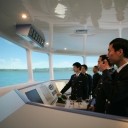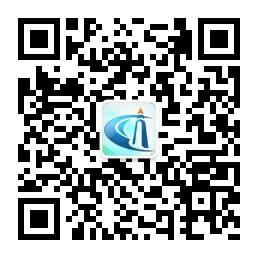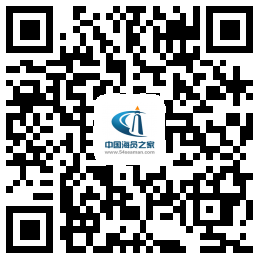返回群组
[交流] ANCHOR !!!
ANCHOR
1. Prior to anchoring, officers involved in the anchoring operation must know how many shackles of cable will be used. The master will decide this taking into account:
(a). Depth of water , and the ship’s draft
(b). Available sea room for swinging
(c). Type of holding ground on the seabed.
(d). Expected weather and amount of hull exposed to the wind
(e) Strength of current and /or tide.
(f) Anticipated duration of anchorage.
A rule of thumb for good weather and good holding ground is for the cable to be paid out to a minimum of four times the depth of water.
During the anchoring process, communication is very vital and the officer on the foc’le must ensure that the bridge is aware of precisely what is happening at all times, as the master is unlikely to be able to see the cable from the bridge. As a standard practice, the officer should report on the following to the bridge :
(a). when the anchor is ready for letting go and also once let go anchor.
(b). as each shackle passes the windlass.
(c) . Direction in which the cable is leading at the same when reporting number of shackle
(d). whenever there is excessive strain on the cable from running ( if this is experienced
the master may have to use the engines to reduce this strain ).
(e). If the cable stops running, even with the brake off ( if there is no tide or wind, the
master may have to use the engines enable the cable to run)
(f). When the anchor is properly “brought up”.
Once anchor is brought up, ensure that the anchor stopper is placed in position, brake is applied and take the gear out from the windlass, make sure the anchor ball is hoisted. And / or the anchor light displayed. Whilst vessel at anchor, both the anchor lashings to be removed and kept ready for immediate use in case of emergency.
2. While at anchor, the bridge must be manned by an officer at all times and shall not be left unattended. As a good practice, upon anchoring, a swing circle must be drawn to monitor the vessel’s position. Vessels at anchor should monitor their position continuously. Hourely record of anchor position is to be maintained in the ‘anchor log’. Positions of other vessels anchored close by should also be monitored by plotting on the radar plotter and/or chaft for effective monitoring. A radar is to be kept switched on throughout the anchor stay for position monitoring. Should the weather be poor or found to be deteriorating. The frequency of fixes recorded should be reduced to half hourly or less. At this point, master to be notified, additional lookout posted on the bridge and anchor party to be on standby status. Accordingly, main enginers to be on short notice or ready for immediate use.
3. Monitoring of the weather condition is very important when at anchor, since sudden change of wind force and direction (e.g. sudden gust of wind or passing squall) can be detrimental to the vessel. Engines are to be kept on short notice when weather condition is poor or squalls are expected.
4. The following actions are to be taken by the OOW should the vesel be suspected of dragging her anchor and/or is in imminent danger by another vessel dragging its anchor or manoeuvring dangerously close:
(a). inform the engine room to stand-by-engine and request for power to the windlass
(b). call the master immediately
(c). Call for anchor station
(d). stand by deck crew.
(e). prepare fenders, where required.
5. When heaving up anchor, communication is also very vital between the officer at the foc’le and the bridge, the bridge should be made aware of the following:
(a). when each shackle passes the windlass, also stating the direction in which the cable is leading.
(b). whenever there is excessive strain on the cable.
(c). when the cable fouls against the vessel i.e. if it leads across the bulbous bow or astern under the vessel with a long lead ( master should use engine to manoeuvre the vessel clear and avoid any damage).
(d). when anchor “aweigh” ( anchor ball to be lowered and/or lights to be switched off accordingly).
(e). when the anchor is sighted clear of the water.
Once anchor is housed-in,. ensure the brake is applied and take the gear out from the windlass. If proceeding to sea, secure the anchor with extra lashings, apply the stopper, and cover the spurling and the hawse pipes. This should ONLY be done when the master has clearly instructed the officer to secure the anchors, usually only after the vessel has cleared port.
1. Prior to anchoring, officers involved in the anchoring operation must know how many shackles of cable will be used. The master will decide this taking into account:
(a). Depth of water , and the ship’s draft
(b). Available sea room for swinging
(c). Type of holding ground on the seabed.
(d). Expected weather and amount of hull exposed to the wind
(e) Strength of current and /or tide.
(f) Anticipated duration of anchorage.
A rule of thumb for good weather and good holding ground is for the cable to be paid out to a minimum of four times the depth of water.
During the anchoring process, communication is very vital and the officer on the foc’le must ensure that the bridge is aware of precisely what is happening at all times, as the master is unlikely to be able to see the cable from the bridge. As a standard practice, the officer should report on the following to the bridge :
(a). when the anchor is ready for letting go and also once let go anchor.
(b). as each shackle passes the windlass.
(c) . Direction in which the cable is leading at the same when reporting number of shackle
(d). whenever there is excessive strain on the cable from running ( if this is experienced
the master may have to use the engines to reduce this strain ).
(e). If the cable stops running, even with the brake off ( if there is no tide or wind, the
master may have to use the engines enable the cable to run)
(f). When the anchor is properly “brought up”.
Once anchor is brought up, ensure that the anchor stopper is placed in position, brake is applied and take the gear out from the windlass, make sure the anchor ball is hoisted. And / or the anchor light displayed. Whilst vessel at anchor, both the anchor lashings to be removed and kept ready for immediate use in case of emergency.
2. While at anchor, the bridge must be manned by an officer at all times and shall not be left unattended. As a good practice, upon anchoring, a swing circle must be drawn to monitor the vessel’s position. Vessels at anchor should monitor their position continuously. Hourely record of anchor position is to be maintained in the ‘anchor log’. Positions of other vessels anchored close by should also be monitored by plotting on the radar plotter and/or chaft for effective monitoring. A radar is to be kept switched on throughout the anchor stay for position monitoring. Should the weather be poor or found to be deteriorating. The frequency of fixes recorded should be reduced to half hourly or less. At this point, master to be notified, additional lookout posted on the bridge and anchor party to be on standby status. Accordingly, main enginers to be on short notice or ready for immediate use.
3. Monitoring of the weather condition is very important when at anchor, since sudden change of wind force and direction (e.g. sudden gust of wind or passing squall) can be detrimental to the vessel. Engines are to be kept on short notice when weather condition is poor or squalls are expected.
4. The following actions are to be taken by the OOW should the vesel be suspected of dragging her anchor and/or is in imminent danger by another vessel dragging its anchor or manoeuvring dangerously close:
(a). inform the engine room to stand-by-engine and request for power to the windlass
(b). call the master immediately
(c). Call for anchor station
(d). stand by deck crew.
(e). prepare fenders, where required.
5. When heaving up anchor, communication is also very vital between the officer at the foc’le and the bridge, the bridge should be made aware of the following:
(a). when each shackle passes the windlass, also stating the direction in which the cable is leading.
(b). whenever there is excessive strain on the cable.
(c). when the cable fouls against the vessel i.e. if it leads across the bulbous bow or astern under the vessel with a long lead ( master should use engine to manoeuvre the vessel clear and avoid any damage).
(d). when anchor “aweigh” ( anchor ball to be lowered and/or lights to be switched off accordingly).
(e). when the anchor is sighted clear of the water.
Once anchor is housed-in,. ensure the brake is applied and take the gear out from the windlass. If proceeding to sea, secure the anchor with extra lashings, apply the stopper, and cover the spurling and the hawse pipes. This should ONLY be done when the master has clearly instructed the officer to secure the anchors, usually only after the vessel has cleared port.
请登录后发帖

 联系我们人工客服
联系我们人工客服



















 :1391995811
:1391995811

